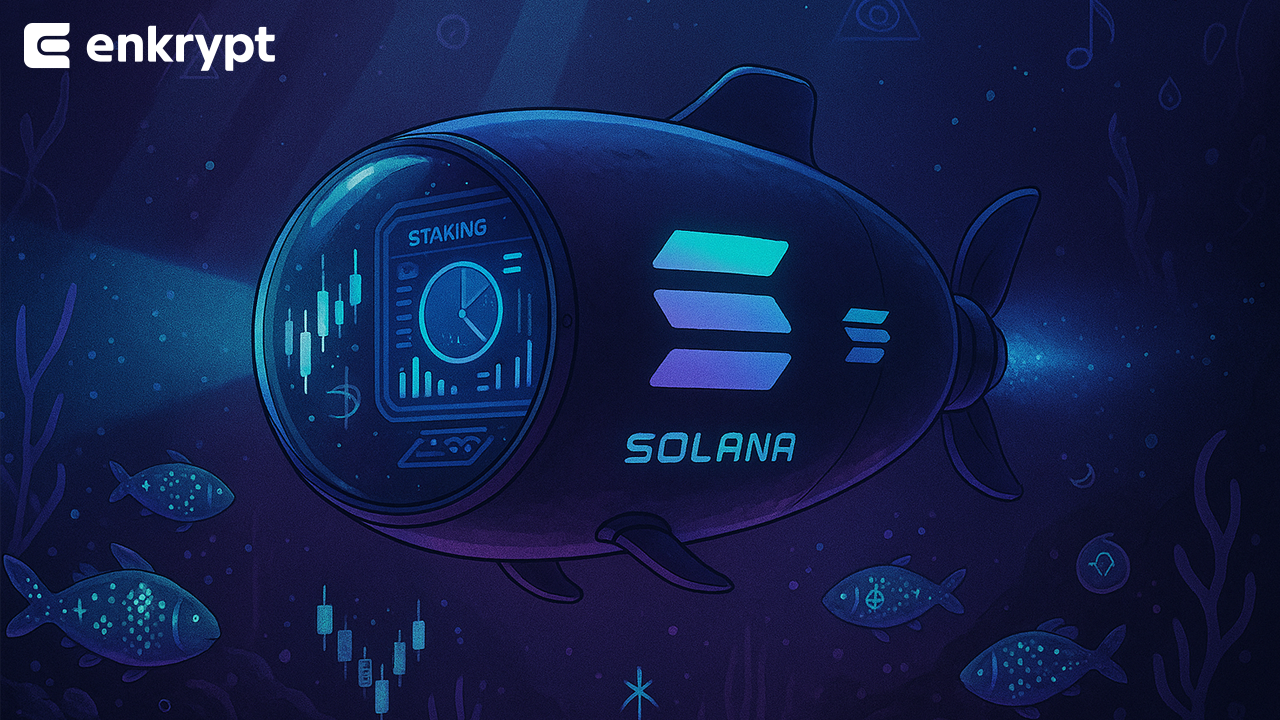A Deep Dive into Solana: Speed, Innovation, and Staking with Enkrypt
If any blockchain is a credible threat to Ethereum it's Solana. But what makes SOL, SOL? Read our blog for a deep dive on the Solana blockchain!

Solana has emerged as one of the most prominent blockchains in the crypto space, known for its quick transaction speed, low costs, and ambitious vision to support the future of decentralized applications. From its inception to its unique architecture and staking opportunities, Solana’s journey has been anything but boring. At MEW, we have always been Ethereum OGs, but as crypto is growing, we bring the best of the multichain world to our users. If you've never transacted on Solana, now is the time to look into it. Here's everything you need to know—including how you can stake SOL easily and securely with Enkrypt.
What is Solana?
Solana is a high-performance, permissionless blockchain designed for scalability. Launched in March 2020 by Anatoly Yakovenko and the Solana Labs team, the network aims to support decentralized applications and crypto projects without sacrificing speed or decentralization.
Unlike many blockchains that rely solely on Proof-of-Stake (PoS) or Proof-of-Work (PoW), Solana introduced a hybrid consensus mechanism called Proof of History (PoH) combined with PoS. PoH acts like a cryptographic clock—helping the network agree on time and order of events, dramatically improving throughput and reducing congestion.
Solana can reportedly process over 65,000 transactions per second (TPS) with block finality in less than a second, all while maintaining extremely low fees. These attributes make it a strong foundation for everything from DeFi platforms and NFT marketplaces to gaming and real-world data applications.
A Brief History
Solana began as a whitepaper in 2017, led by Yakovenko's vision of solving the blockchain scalability trilemma. The project quickly gained attention and funding, raising over $25 million in public and private rounds before launching its mainnet in 2020.
Its ecosystem grew rapidly during the 2021 bull market, with applications like Serum (a decentralized exchange), Phantom Wallet, and NFT collections like Degenerate Ape Academy putting Solana in the spotlight. SOL, the native token, reached an all-time high of over $260 in November 2021 (to be surpassed only in January 2025 by a new ATH of $290+).
Challenges and Controversies
Solana's journey hasn’t just been about speed and innovation—it's also full of colorful moments, unexpected challenges, and a few scandals that have helped shape its reputation.
One of the most infamous issues has been network outages. While Solana is known for high throughput, its complex infrastructure has faced growing pains. The network has experienced several periods of downtime, often triggered by spam attacks or bugs in validator software. At one point in 2022, the network went down multiple times in just a few months. These incidents sparked debates over centralization, as a relatively small group of validators was able to halt and restart the chain—something that raised concerns among decentralization purists.
Another major moment of controversy came with Solana’s association with FTX and Alameda Research. The now-defunct crypto exchange and its sister trading firm were early and heavy backers of Solana. When FTX collapsed in November 2022, the fallout hit Solana hard. SOL's price plummeted, and public sentiment took a dive due to perceived overexposure to Sam Bankman-Fried's empire. However, the Solana ecosystem showed surprising resilience, with community-led projects stepping up and builders continuing to innovate despite the shakeup.
On a lighter note, Solana has developed a reputation for embracing NFT culture and internet memes. During the NFT boom, collections like Degenerate Ape Academy, Solana Monkey Business, and Okay Bears brought mainstream attention to the chain. Solana also saw the rise of meme coins like BONK, which rallied the community and created viral moments. These lighthearted projects showcase Solana’s vibrant, fast-moving culture—one that’s not afraid to have fun while pushing the boundaries of blockchain technology.
Notable Projects on Solana
Solana’s low latency and transaction costs have attracted developers across verticals:
- Magic Eden – A leading NFT marketplace.
- Jito – A liquid staking protocol that also helps maximize MEV rewards.
- Marinade Finance – A popular staking and DeFi platform.
- Drip Haus – A music NFT platform for creators.
- Helium – A decentralized wireless network that migrated to Solana for scalability.
Solana also supports a growing ecosystem of mobile-first experiences through Solana Mobile and the Saga phone, pioneering web3-native smartphone tools.
Staking on Solana
Staking is an essential part of how the Solana network operates. By staking your SOL tokens, you’re helping to secure the blockchain and keep it running efficiently. Validators—who process and validate transactions—rely on delegations from token holders to maintain consensus and ensure the network’s integrity. In return for contributing to network security, stakers earn regular rewards in SOL, making it a popular way to earn passive rewards while holding the asset.
Solana uses a combination of Proof of Stake (PoS) and Proof of History (PoH) to achieve its fast speeds and high throughput. Unlike some staking systems that require long lock-up periods or slashing risks, Solana allows stakers to maintain control over their funds with the option to unstake at any time (though there is a cooldown period). Historically, staking SOL has provided annual rewards ranging from 5% to 7% APY, though rates can vary based on validator performance, network parameters and unique benefits offered by staking providers.
Stake SOL with Enkrypt: A Seamless, Multichain Experience
Enkrypt is a multichain wallet built by the team behind MyEtherWallet (MEW)—trusted since the early days of Ethereum. Designed to help users explore the growing multichain world, Enkrypt makes it easy to manage assets, interact with dApps, and stake tokens—all in one place.
Why Stake with Enkrypt?
- Simple, User-Friendly Interface – Stake your SOL with just a few clicks.
- Secure and Transparent – Self-custodial by design. You always control your keys.
- Backed by P2P.org – Enkrypt integrates with P2P.org, one of the most trusted staking providers, securing over $7 billion in assets across 50+ networks. Their performance optimization ensures high uptime and maximized staking rewards.
Whether you’re a newcomer looking to earn passive income or a seasoned user managing multiple assets, Enkrypt provides a seamless way to stake SOL and other tokens across multiple ecosystems—without needing separate wallets or apps.
Ready to stake your SOL? Head to Enkrypt Staking to get started and use this guide to learn how.
Final Thoughts
Solana stands out for its ambitious scalability, diverse ecosystem, and relentless community—even through turbulent times. While it has faced challenges, it remains a major force in the blockchain world, with innovative features and a growing array of dApps.
If you’re holding SOL, staking is one of the best ways to support the network and earn rewards. And with Enkrypt, the process is secure, streamlined, and backed by battle-tested infrastructure. Explore Solana, stake with confidence, and be part of the movement shaping the future of decentralized technology.
Thank you for checking out our Solana Overview article! Don't forget to download Enkrypt for a seamless web3 multichain wallet experience. We would love to hear from you on our social media about any guide suggestions you have for the future. Also, if you enjoy using mobile cryptocurrency wallets, give our MEW Mobile app a try, it's available on both iOS and Android platforms!

